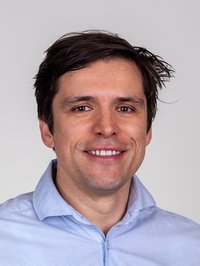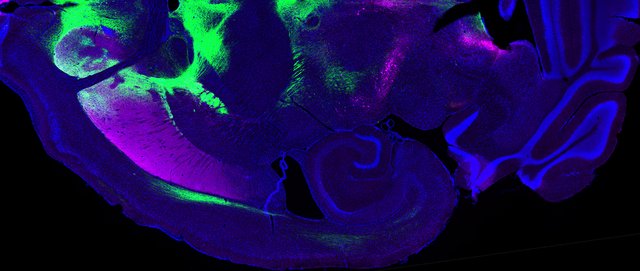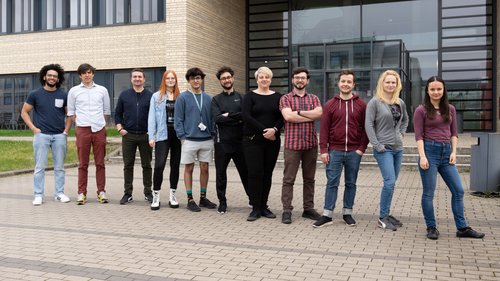Research Group Neuromodulatory Networks
Psychiatric disorders such as severe depression or attention disorders have long been associated with an altered level of neuromodulators in certain brain areas. Our team is interested in understanding changes in neuromodulators such as dopamine, serotonin or norepinephrine in the brain. However, altered levels of neuromodulation are not only related to many psychiatric disorders, but also influence cognitive performance in everyday life: fatigue, agitation and sadness are all correlated with activity patterns of neurons that release such neuromodulators.
While specific behaviour patterns have been associated with certain neuromodulators and the activation of certain receptors and their downstream signalling pathways have also been associated with these neuromodulators, it is still unknown today how neuromodulatory neurons function, how they adapt and how their global projections still permit surface specificity.
- Head
Head

Matthias Prigge studied biochemistry at the Freie Universität Berlin and philosophy at the Humboldt-Universität Berlin. He then received his doctorate in experimental biophysics from the Humboldt University in Peter Hegemann's laboratory where he was fascinated by microbial rhodopsins. Today, these proteins are commonly used to manipulate neuronal activity of neurons in animal behavior with light.
Prigge then worked as a postdoc with Ofer Yizhar at the Weizmann Institute in Israel. There he was particularly interested in how neuromodulatory systems adapt to environmental stimuli.In his own lab, he wants to use his different skills to develop new optical tools and technologies for the analysis of neuromodulatory networks.
- Members
Members
Leiter Dr. Matthias Prigge +49-391-6263-94411 matthias.prigge@lin-magdeburg.de Sekretariat Beate Traoré +49-391-6263-95481 beate.traore@lin-magdeburg.de Postdocs Dr. Maria Paz Contreras Santander
+49-391-6263-94451 Maria.Contreras@lin-magdeburg.de Dr. Ernesto Duran
+49-391-6263-94451 ernesto.duran@lin-magdeburg.de Dr. Thomaz Fabrin
+49-391-6263-92211 thomaz.fabrin@lin-magdeburg.de Dr. Cristian Gonzalez Cabrera
+49-391-6263-94411 Cristian.Gonzalez@lin-magdeburg.de PhD students Ahmed Adel Ahmed Aly
+49-391-6263-94351 Ahmed.Aly@lin-magdeburg.de Julia Büscher +49-391-6263-94611 julia.buescher@lin-magdeburg.de Andres Jaramillo Flautero +49-391-6263-94611 AndresMauricio.JaramilloFlautero@lin-magdeburg.de Hassan Hosseini +49-391-6263-92211 hassan.hosseini@lin-magdeburg.de Kaushik More
+49-391-6263-94611 kaushik.more@med.ovgu.de Technical staff member Celina Dölle +49-391-6263-92211
celina.doelle@lin-magdeburg.de Katharina Dragendorf +49-391-6263-94611 katharina.dragendorf@lin-magdeburg.de Melissa Reimann +49-391-6263-92411 melissa.reimann@lin-magdeburg.de - Current Third Party Funds
Current Third Party Funds
2021 - 2024
ASAP-020505 “Activity and connectivity drive neuronal vulnerability and disease progression in Parkinson’s disease”
https://parkinsonsroadmap.org/research-network/#2021
EU Joint Program - Neurodegenerative Diseases Research
https://www.neurodegenerationresearch.eu/2020 - 2023
CBBS Neuronetwork
"Stimulation of the LC-NE system as a personalized therapeutic intervention"2020 - 2023
Special LIN Project together with Dr. Karpova
"Autophagy meets Sleep"2020 - 2022
Alexander von Humboldt Stiftung
"Dr. Thomaz Fabrin: Ultra-light sensitive Opsins for transcutaneous Optogenetics"2018-2023
Leibniz Competition "Best Minds" - Publications
Publications
2022
Holder, Damaris & Prigge, Matthias (2022), Spatial and temporal considerations of optogenetic tools in an all-optical single-beam experiment In: Papagiakoumou E. (eds) All-optical methods to study neuronal function. Neuromethods Vol. 191, Humana Press, New York, NY.
Goldenberg, Adi Miriam; Schmidt, Sarah; Mitelman, Rea; Levy, Dana Rubi; Prigge, Matthias; Katz, Yonatan; Yizhar, Ofer; Beck, Heinz; Lamp, Ilan (2022). Localized chemogenetic silencing of inhibitory neurons: a novel mouse model of focal cortical epileptic activity. Cerebral Cortex. https://academic.oup.com/cercor/advance-article/doi/10.1093/cercor/bhac245/6628689
Wetzel, Nicole; Widmann, Andreas; Schöllkopf, Ursula; Prigge, Matthias and Krauel, Kerstin (2022). “A New Paradigm to Assess Pupil Dilation as a Marker of Dysfunctional Arousal Regulation in Children and Adolescents with ADHD.” PsyArXiv. https://psyarxiv.com/q3c9e/
Baral, Shristi; Hosseini, Hassan; More, Kaushik; Fabrin, Thomaz M. C.; Braun, Jochen & Prigge, Matthias (2022). Spike-Dependent Dynamic Partitioning of the Locus Coeruleus Network through Noradrenergic Volume Release in a Simulation of Nucleus Core. Brain Sci. (Towards Understanding the Functional Connectivity of the Locus Coeruleus). https://www.mdpi.com/2076-3425/12/6/728
2021
Farmer A … Prigge M, Flautero AJ, More K. ... & König J. 2020. Minimum Reporting Standards in Research on Transcutaneous Vagus Nerve Stimulation. Frontiers Human Neuroscience, https://doi.org/10.3389/fnhum.2020.568051
2020
Vemula SK, Malci A, Junge L, Lehmann A-C, Rama R, Hradsky J, Matute RA, Weber A, Prigge M, Naumann M, Kreutz MR, Seidenbecher CI, Gundelfinger ED, Herrera-Molina R. 2020. TRAF6 controls spinogenesis instructing synapse density and neuronal activity through binding neuroplastin. bioRxiv. https://doi.org/10.1101/768341
2017
Klavir O, Prigge M, Sarel A, Paz R, Yizhar O. 2017. Manipulating fear associations via optogenetic modulation of amygdala inputs to prefrontal cortex. Nature Neuroscience. 20(6):836-844. Available from: 10.1038/nn.4523
Tkatch T, Greotti E, Baranauskas G, Pendin D, Roy S, Nita LI, Wettmarshausen J, Prigge M, Yizhar O, Shirihai OS, Fishman D, Hershfinkel M, Fleidervish IA, Perocchi F, Pozzan T, Sekler I. 2017. Optogenetic control of mitochondrial metabolism & Ca2+ signaling by mitochondria-Targeted opsins. Proceedings of the National Academy of Sciences of the United States of America. 114(26):E5167-E5176. Available from: 10.1073/pnas.1703623114
Tsunoda SP, Prigge M, Abe-Yoshizumi R, Inoue K, Kozaki Y, Ishizuka T, Yawo H, Yizhar O, Kandori H. 2017. Functional characterization of sodium-pumping rhodopsins with different pumping properties. PLoS ONE. 12(7). Available from: 10.1371/journal.pone.0179232
Wiegert JS, Mahn M, Prigge M, Printz Y, Yizhar O. 2017. Silencing Neurons: Tools, Applications, and Experimental Constraints. Neuron. 95(3):504-529. Available from: 10.1016/j.neuron.2017.06.050
2016
Mahn M, Prigge M, Ron S, Levy R, Yizhar O. 2016. Biophysical constraints of optogenetic inhibition at presynaptic terminals. Nature Neuroscience. 19(4):554-556. Available from: 10.1038/nn.4266
Wietek J, Prigge M. 2016. Enhancing channelrhodopsins: An Overview. In Methods in Molecular Biology. Humana Press Inc. pp. 141-165. (Methods in Molecular Biology). Available from: 10.1007/978-1-4939-3512-3_10
2015
Scott N, Prigge M, Yizhar O, Kimchi T. 2015. A sexually dimorphic hypothalamic circuit controls maternal care and oxytocin secretion. Nature. 525(7570):519-522. Available from: 10.1038/nature15378
2014
Pashaie R, Anikeeva P, Lee JH, Prakash R, Yizhar O, Prigge M, Chander D, Richner TJ, Williams J. 2014. Optogenetic brain interfaces. IEEE Reviews in Biomedical Engineering. 7:3-30. Available from: 10.1109/RBME.2013.2294796
2013
Akerboom J, Calderón NC, Tian L, Wabnig S, Prigge M, Tolö J, Gordus A, Orger MB, Severi KE, Macklin JJ, Patel R, Pulver SR, Wardill TJ, Fischer E, Schüler C, Chen TW, Sarkisyan KS, Marvin JS, Bargmann CI, Kim DS, Kügler S, Lagnado L, Hegemann P, Gottschalk A, Schreiter ER, Looger LL. 2013. Genetically encoded calcium indicators for multi-color neural activity imaging and combination with optogenetics. Frontiers in Molecular Neuroscience. (FEB). Available from: 10.3389/fnmol.2013.00002
2012
Erbguth K, Prigge M, Schneider F, Hegemann P, Gottschalk A. 2012. Bimodal Activation of Different Neuron Classes with the Spectrally Red-Shifted Channelrhodopsin Chimera C1V1 in Caenorhabditis elegans. PLoS ONE. 7(10). Available from: 10.1371/journal.pone.0046827
Prigge M, Schneider F, Tsunoda SP, Shilyansky C, Wietek J, Deisseroth K, Hegemann P. 2012. Color-tuned channelrhodopsins for multiwavelength optogenetics. Journal of Biological Chemistry. 287(38):31804-31812. Available from: 10.1074/jbc.M112.391185
2011
Yizhar O, Fenno LE, Prigge M, Schneider F, Davidson TJ, Ogshea DJ, Sohal VS, Goshen I, Finkelstein J, Paz JT, Stehfest K, Fudim R, Ramakrishnan C, Huguenard JR, Hegemann P, Deisseroth K. 2011. Neocortical excitation/inhibition balance in information processing and social dysfunction. Nature. 477(7363):171-178. Available from: 10.1038/nature10360
Zhang F, Vierock J, Yizhar O, Fenno LE, Tsunoda S, Kianianmomeni A, Prigge M, Berndt A, Cushman J, Polle J, Magnuson J, Hegemann P, Deisseroth K. 2011. The microbial opsin family of optogenetic tools. Cell. 147(7):1446-1457. Available from: 10.1016/j.cell.2011.12.004
2010
Berndt A, Prigge M, Gradmann D, Hegemann P. 2010. Two open states with progressive proton selectivities in the branched channelrhodopsin-2 photocycle. Biophysical Journal. 98(5):753-761. Available from: 10.1016/j.bpj.2009.10.052
Prigge M, Rösler A, Hegemann P. 2010. Fast, repetitive light-activation of CaV3.2 using channelrhodopsin 2. Channels. 4(3). Available from: 10.4161/chan.4.3.11888
- Methods
Methods

- Patch-Clamp in acute slices and cell culture
- In-vivo electrophsiology
- Mouse behavior
- Immunostaining + Clarity
- Photoreceptor design and Optogenetics


